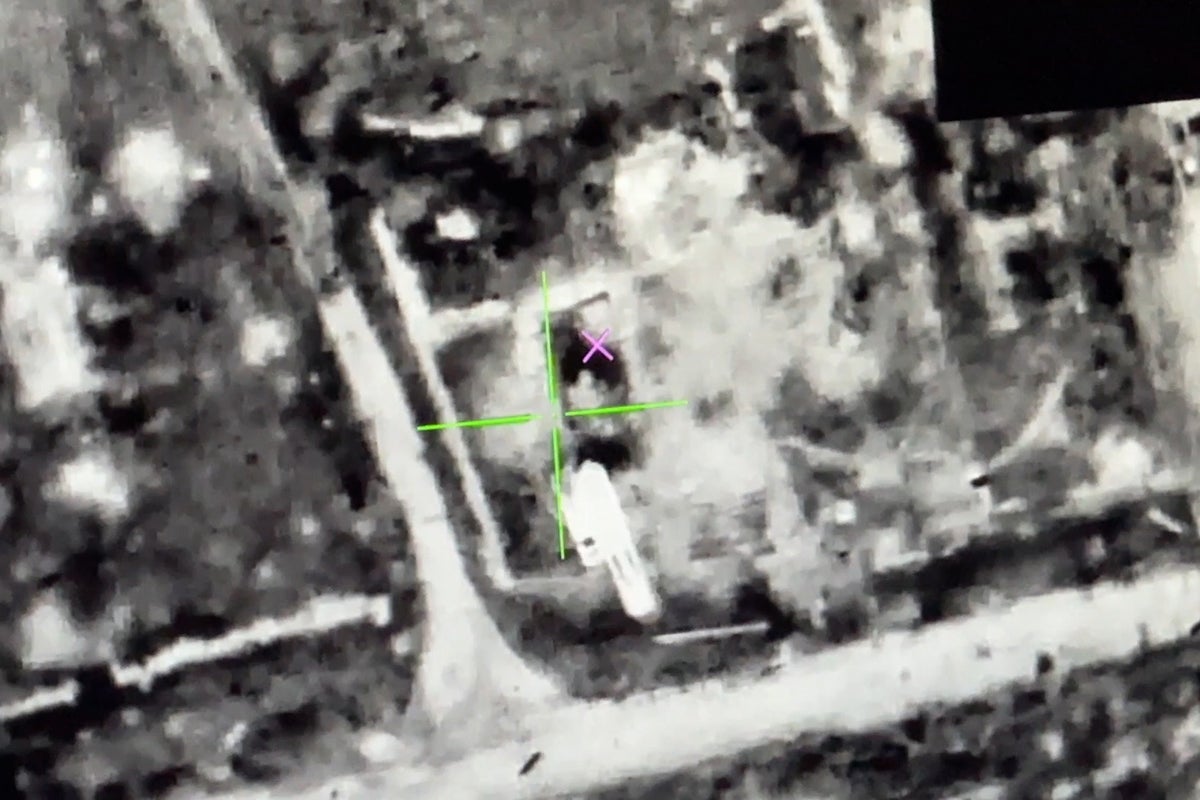Latest News
How Ukraine and Russia are playing out a deadly cat and mouse drone war from underground bunkers
Published
2 months agoon
By
admin
Ramzan darts about his garage workshop with gleeful enthusiasm, showing off a small blue mortar bomb from “Holland or Poland”, a whopping thin-tailed, bulging-headed shell from America, Ukrainian bespoke high-explosive packed grenades and even an anti-tank mine – all for dropping on the heads of Russians.
A former infantry soldier, he has been at war for three years and says he misses the thrill of fighting up close, but, as the armourer for a four-man drone team flying an unmanned bomber in the National Guard’s Typhoon drone unit: “This is the best way to kill Russians.”
In a war of constant frontline improvisation, workshops like Ramzan’s garage – where he makes his own detonators and devises new types of incendiary bombs – have taken on the value of billion-pound industrial-military research centres in Nato countries.
Drone war was pioneered by self-funded Ukrainian soldiers adapting civilian toys to mortal effect. Kyiv now has the capacity to produce drones by the million, but on the front lines the model remains a killer startup.
Ramzan’s crew, Team Grey, is led by an older former infantry officer, whom we are not naming, who has been at war for 10 years and has family living under Russian occupation in the Donbas. He is waiting in a bunker not far away but within range of the enemy in Kamyanske, south of Zaporizhzhia.
Ramzan makes his own detonators and devises new types of incendiary bombs in a garage south of Zaporizhzhia (The Independent)Russia’s army has tried to punch through Ukrainian lines here over the last three weeks. It has used armoured attacks but been stalled by Ukrainian drones and infantry – and is taking and losing ground at a staggering and bloody cost.
Ramzan’s pick-up is loaded with charged briefcase-sized drone batteries and boxes of bombs as he sets off to join his crew. The last few miles are driven along potholed roads and dirt tracks at eye-screwing speed in darkness illuminated only by sidelights. Ramzan would rather die in a road accident than a Russian drone strike and this is the hunting ground of the first person view (FPV) Kremlin drone pilots.
Working under red torchlight, the team unload the car, which is tucked under camouflaged netting, and head into a strip of woodland. Ukrainian artillery fire sporadic shells south – they ignore the outgoing blast, and mutter annoyance. Artillery attracts Russian drones.
“Noisy neighbours,” someone says in the pause that follows.
In near silence, a tarpaulin is torn off the Typhoon and it’s checked for the night’s operations. They have five missions with targets assigned by Ukraine’s intelligence system. They also have to react to live reports of Russian troop movements.
Ramzan tucks some bombs under a bush, ready to arm the quadcopter, a six-foot-square box of carbon fibre Meccano struts with a wig of aerials.
The bombs are loaded onto a drone which is hidden under tarpaulin in the scrubland (The Independent)It is flown remotely from an eight-foot-square bunker dug into the earth by hand and roofed with dirt and tree trunks. Half the space is taken up with a computer showing a live feed from the Typhoon that Avi, the pilot, will use to fly.
Another computer shows a multiscreen feed from drones flying over the battlefield. Chillingly, some of these are Russian hunter-killer FPVs seeking targets – like the Grey crew’s bunker.
Ramzan and his assistant carry the Typhoon into a field, quickly attach two bombs to clips under its belly and arm the devices in the red glow of their head torches. As soon as they are back in the bunker, Avi takes off.
After a few minutes, the Typhoon’s navigation goes haywire and the compass packs up. It has been jammed by Ukraine’s own equipment and it lurches about as Avi struggles to control it with imperceptible tweaks on the controls he pinches between thumb and forefinger.
“I’ll have to get it back to us,” he mutters.
The Typhoon’s whine is soon audible above the bunker. It’s carrying a penetrator bomb and 4kg of high explosive designed to kill Russians in a hole much like this one.
There’s silence as Avi brings it back onto the field – blades of grass flap in the monochrome video feed of its down-draught – the bombs are not safe until Ramzan crawls out to untwist his detonators and re-attach their safety pins.
Avi, the drone’s pilot, is responsible for releasing the bombs (The Independent)There’s a sigh in the bunker and when a few minutes later there’s the unmistakable biscuit crunch of an incoming artillery shell exploding nearby, it goes unremarked.
Soon the craft is airborne again, now armed with three bombs and with orders to hit another suspected Russian bunker in Kamyanske.
Avi takes the drone over the village. The black and white video feed intensifies the vision of horror below. Like almost all of the 1,300km frontline in Ukraine, the war is being fought in rubble. Tiny groups of infantry try to hide in the blasted mess of masonry and shattered timber below.
A black hole is the target. Previous reconnaissance suggests that two men are hiding in a bunker under a tangle of roof struts here. Avi drops three bombs. Each blooms on the screen as it explodes.
Ramzan is happy, he says – his detonators worked. Avi, an engineer by trade, is untroubled by the idea that he may have killed some human beings.
“They’ve come here to kill and take our land. I’ll kill as many as I can,” he says while having a quick stretch between sorties which then drag on for an hour or more.
The Russians have interceptor drones in the area and have also launched a series of air strikes nearby. We can see them a couple of miles away on the ground-level monitor in the trees outside. We can feel the thumps of the explosions through the earth.
The drone operators rely on video feed to make sure their targets are accurate (The Independent)“In military doctrine we should have a soldier every ten metres of the front line but we cannot do that, so we have drones,” says Team Grey’s leader. Russia’s mass attacks have been blocked and stopped by Ukraine’s fast adoption of the unmanned craft in this war that has upended decades of military thinking to Kyiv’s advantage.
The Soviet-era assumption that Russia could send more men to fight and die than the other side and prevail through sheer numbers has been destroyed, along with the Kremlin’s armoured columns.
No soldier on either side wants to go to war in an armoured personnel carrier now. Enemy drones turn them into blazing ovens for a few hundred dollars a hit.
Grey team are ordered to react to newly spotted Russian infantry in the village. Two men are seen moving above ground. In the past, skilled infiltrators have used thermal blankets and stealth to sneak up on Ukrainian drone crews and slaughter them at night.
The Typhoon is soon whining high out of earshot at about 60kmph. All eyes in the bunker are on the video feeds. There are blobs of black showing vegetation amid the rubble of the town.
“Typhoon, stop!” the Ukrainian controller says over the messaging system. He can see Avi’s feed and knows better where the men are hiding.
They may be special forces reconnaissance – Russian Spetsnaz elite soldiers. They may be stormtroopers gathering for an assault. They may be conscripts who’ve lost their nerve and want to escape the holes where they’ve been forced to live.
No matter. Avi drops one, then two bombs, which flower briefly in black and white. The controller adjusts his aim and two more bombs are dropped. It’s impossible to see what, if anything, has been hit.
Avi controls the drone remotely from an underground bunker, dug out by hand (The Independent)Avi is frustrated. He rewinds recordings of the hits in slow motion for about an hour, seeking, frame by frame, any evidence that he has taken some lives. He’s soft spoken, tired. He doesn’t keep count, although his predecessor in the bunker had scratched his human score card onto the silver insulation paper on the walls.
He need not have worried. Avi did kill. Ukrainian reconnaissance footage later shows, in colour video, three torn and mangled bodies lying in the shade of the village’s trees.
As dawn approaches, the night’s work is over and Ramzan races back to his workshop to charge batteries and make more bombs.
As he tears along an empty road at breakneck speed, the radio plays Sade’s Smooth Operator.
He smiles.


Vardan Oskanian: The preservation of the state depends on a decisive national awakening

Turkey opens new military factory in Azerbaijan

High-ranking clergy who met with PM Pashinyan issue online petition for electing new Catholicos of All Armenians

Artsakh has no natural gas for 4th day, negotiations with Azerbaijan continue

Italy’s Palermo unanimously recognizes Artsakh independence

Captured in Artsakh terrorist says they were promised $ 100 for each severed head of ‘kafir’

NEWS.am latest, 03.11.20: Nagorno-Karabakh authorities have evidence of Azerbaijan using prohibited weapons in Artsakh

Captured in Artsakh terrorist says they were promised $ 100 for each severed head of ‘kafir’

